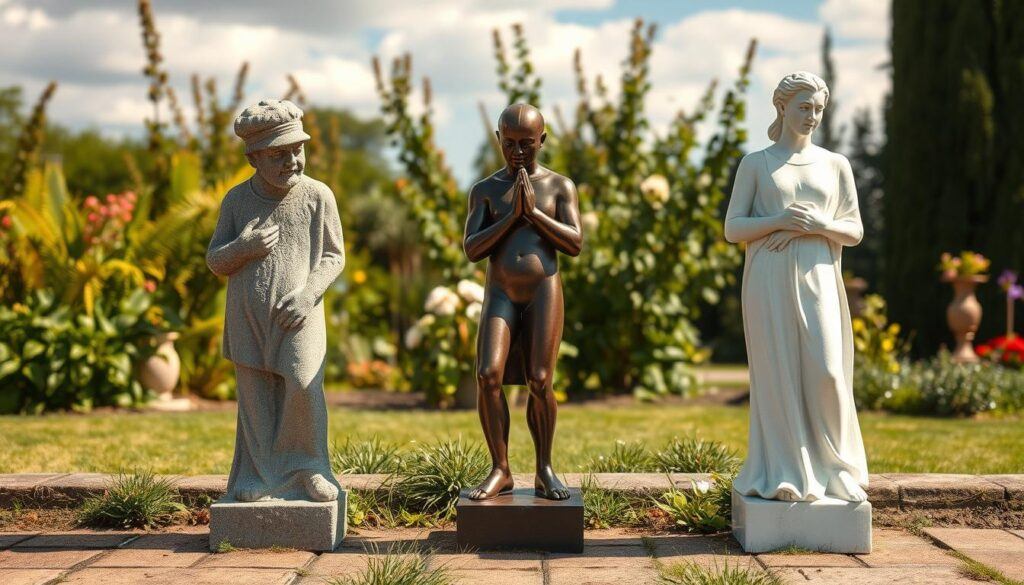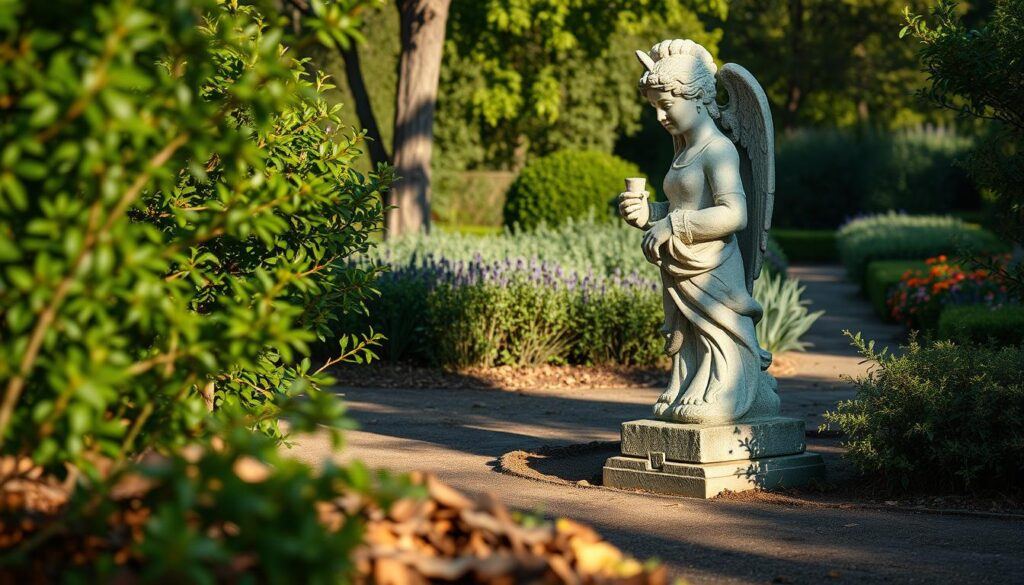Some of the links in this post are affiliate links, which means I may earn a small commission if you make a purchase through those links. This comes at no extra cost to you. Thank you for your support!
Choosing the right outdoor statues for my garden decor is key. I must think about my budget, how long they’ll last, and the weather. These factors are important.
Stone garden statues bring timeless beauty. Metal statues add a touch of art. Resin statues offer a fresh, modern look. I’ll look at these options to decide what’s best for me.
Key Takeaways
- Consider budget, durability, and climate when choosing a material.
- Stone, metal, and resin are popular materials for outdoor statues.
- Each material has its unique characteristics and advantages.
- Climate and maintenance needs vary across materials.
- Personal style and garden decor preferences play a significant role.
The Transformative Power of Garden Statuary
Garden sculptures have been a key part of landscape design for centuries. They add a unique beauty to outdoor spaces. This beauty reflects the owner’s personality, making the space special.
Historical Significance of Outdoor Sculptures
Outdoor sculptures have always carried cultural and artistic meaning. From ancient Greek and Roman statues to modern abstract pieces, they’ve been vital in outdoor decor. These sculptures often share stories, mark important events, or simply add beauty to gardens.
Creating Focal Points in Landscape Design
In today’s landscape design, statues serve as focal points. They draw the eye to certain areas of the garden. Some benefits include:
- Adding depth and visual interest
- Creating a sense of balance and harmony
- Providing a unique conversation piece
By adding garden statuary to landscape design, homeowners can make their outdoor spaces more engaging and beautiful.
Why Material Selection Matters for Outdoor Decor
Choosing the right material for garden statues is key for both looks and durability. When picking a statue for your outdoor area, think about how the material will change your garden’s look and feel.
Impact on Garden Aesthetics
The material of your garden statue greatly affects your outdoor decor’s look. For example, stone statues bring a classic, timeless vibe. Metal statues offer a modern, sleek appearance. Resin statues, meanwhile, are versatile and can look like other materials. The material’s texture, color, and style should match your garden’s design.
Practical Considerations for American Climates
When picking a statue material, weather resistance is a big deal. American weather varies a lot, from cold winters to hot summers. A material that can handle these extremes is crucial. Some materials might fade or crack in extreme weather.
| Material | Weather Resistance | Aesthetic Appeal |
| Stone | High | Classic, Timeless |
| Metal | Medium | Modern, Sleek |
| Resin | Medium | Versatile, Design Variability |
Stone Garden Statues: Timeless Elegance in Your Landscape
Stone statues have been a key part of garden design for centuries. They mix art and nature beautifully. These statues can turn an outdoor space into a peaceful and welcoming place.
Stone garden statues come in many types, each made from different stones. Each stone has its own look and lasts a long time. Knowing about these differences helps us see their beauty as they age.
Types of Stone Used in Garden Sculptures
Many stones are used for garden statues, like limestone, sandstone, marble, and granite. Each stone adds its own special touch to the statue’s look and feel.
Limestone and Sandstone Characteristics
Limestone and sandstone are favorites for statues because they’re easy to work with and look great. Limestone has a soft, smooth feel. Sandstone has a grainy texture that brings a natural, earthy vibe.
Marble and Granite Durability
Marble and granite are known for lasting a long time and looking good. Marble shines with luxury. Granite is very hard and lasts forever, perfect for outdoor statues.
The Natural Aging and Patina Process
Stone statues get a beautiful patina as they age. This weathered look adds character and depth. It’s a big part of their charm.
A famous landscape designer said, “The patina on a stone statue is like a badge of honor, telling the story of its history and the environment it’s been a part of.”
“A well-placed stone statue can become a focal point in your garden, evolving in beauty as it ages.”

Stone Garden Statues
Metal Garden Statues: Adding Artistic Dimension
Metal garden statues add a special touch to outdoor decor. They come in various materials to match different tastes. These statues can make any garden look elegant and sophisticated.
Bronze, Copper, and Cast Iron Options
There are many materials for metal garden statues, each with its own charm. Bronze statues are durable and don’t rust easily, making them a favorite. Copper statues get a lovely patina over time, enhancing their beauty. Cast iron statues offer a rustic and classic look.
| Material | Durability | Aesthetic Appeal |
| Bronze | High | Elegant, sophisticated |
| Copper | Medium | Unique patina, attractive |
| Cast Iron | High | Rustic, traditional |
Weathering Effects and Character Development
As metal statues weather, they gain a unique charm. The weathering adds a patina, making them look aged and authentic.
Rust-Resistant Treatments
To keep metal statues from rusting, rust-resistant treatments are used. These treatments help the statue last longer and look better.
Artistic Possibilities with Metal
Metal statues offer endless artistic possibilities. They allow for detailed designs and intricate details. Metal’s versatility lets artists create stunning pieces that last for years.
Resin Garden Statues: Modern Alternatives
Garden lovers are finding new ways to beautify their outdoor spaces. Resin garden statues are becoming a hit. They mix style, durability, and flexibility in a unique way.
Manufacturing Techniques and Quality Variations
Resin statues are made through different methods, affecting their quality and life span. High-end resin statues use “cold casting.” This method combines resin with a hardener and pours it into molds. It creates detailed and smooth finishes.
UV-Resistant Formulations
Resin statues stand out because they resist UV damage. Special coatings shield them from sunlight. This keeps their colors bright and their look fresh for years.
Hollow vs. Solid Construction
Resin statues can be either hollow or solid. Hollow ones are lighter and cheaper. Solid ones are more durable and stable. The choice depends on the statue’s size and detail level.
Faux Finishes and Imitation Textures
Many resin statues have faux finishes and textures. These mimic natural materials like stone or metal. They add realism and enhance the statue’s look. Finishes range from bronze to stone-like, boosting the statue’s visual appeal.
| Feature | Hollow Construction | Solid Construction |
| Weight | Lighter | Heavier |
| Cost | More affordable | More expensive |
| Durability | Less durable | More durable |
Head-to-Head Durability: Weather Resistance Compared
Choosing the right material for garden statues is key. It affects how long they last. Each material handles outdoor weather differently.
Freeze-Thaw Cycle Performance
Materials must handle freeze-thaw cycles well, especially in cold areas. Stone statues usually do well because they’re naturally tough. But, some stones might crack more easily.
Metal statues, like cast iron, also stand up to these cycles but can rust. Resin statues are light and flexible but may not handle freezing and thawing as well.
Sun Exposure and Fading Concerns
Sunlight can make garden statues fade and change color. Resin statues with UV-resistant coatings stay colorful longer. On the other hand, metal statues might get a nice patina over time.
Stone statues usually keep their color, but some stones might fade a bit.
Expected Lifespan by Material
The life of a garden statue depends on its material and the weather. Here’s a table showing how long different statues last:
| Material | Average Lifespan | Factors Affecting Lifespan |
| Stone | 20-50 years | Weathering, cracking |
| Metal | 15-30 years | Rust, corrosion |
| Resin | 5-15 years | Fading, cracking |

Knowing how materials handle weather helps pick a statue that lasts. Homeowners can make better choices.
Maintenance Requirements and Seasonal Care
Keeping garden statues in good shape is more than just cleaning them now and then. It’s about knowing how to care for each material. This ensures your outdoor decorations last longer.
Stone Statue Preservation Techniques
Stone statues need special care to stay in top shape. Sealing them often helps shield them from the weather. A soft-bristled brush is good for cleaning off dirt and grime. For tough stains, a gentle soap solution might be needed.
Metal Maintenance and Corrosion Prevention
Metal statues need regular upkeep to avoid rust. A rust-inhibiting coating can help protect them from moisture. It’s also important to check for rust signs often, so you can fix it early.
Resin Cleaning and Repair Methods
Resin statues are easy to care for but still need cleaning sometimes. A soft cloth and mild soap are enough for most cleanings. If a resin statue gets damaged, there are repair kits that can fix it.
| Material | Cleaning Method | Protective Measures |
| Stone | Mild detergent solution, soft-bristled brush | Periodic sealing |
| Metal | Soft cloth, mild soap solution | Rust-inhibiting coating |
| Resin | Mild soap solution, soft cloth | UV-resistant coating (optional) |
By following these care tips, you can keep your garden statues looking great for many years. This way, you’ll enjoy their beauty for a long time.
Investment Analysis: Cost vs. Long-Term Value
As a homeowner, I must think about the cost of a garden statue and its long-term value. It’s key to analyze the investment, comparing the initial cost to its future worth.
The cost of garden statues changes based on the material. Let’s look at the price ranges for different materials.
Initial Price Ranges by Material
| Material | Low-End Price | High-End Price |
| Stone | $100 | $1,000 |
| Metal | $50 | $500 |
| Resin | $20 | $200 |
The long-term value of a garden statue depends on depreciation and appreciation. Resin statues might lose value faster. But, stone and metal statues can gain value over time because they last longer and look better.
Depreciation and Appreciation Factors
Many things can change a garden statue’s value, like how long it lasts, how easy it is to keep up, and what’s in style. Knowing these can help make smart investment choices.
Replacement vs. Restoration Economics
When a garden statue wears out, you have to choose between getting a new one or fixing the old one. Fixing it can save money, especially for durable materials like stone or metal. Thinking about the cost of fixing versus buying new is important.
Installation Challenges: Weight and Placement Considerations
Garden statues can add beauty to your garden. But, their weight and where you place them need careful thought. It’s not just about putting a statue in your garden. You must think about making it stable and lasting.
Foundation Requirements for Different Materials
The base needed for a garden statue depends on its material. Heavy stone statues need a strong, flat base to avoid moving or falling. Metal statues might need a less solid base but still need careful placement to handle wind and weather.

Seasonal Relocation Possibilities
Some statues, like those made from resin, can be moved with the seasons. This helps protect them from bad weather or lets you change your garden’s look. But, moving heavy statues made from stone or metal is harder. They might need to stay in one place.
Professional vs. DIY Installation
DIY installation can save money for smaller, lighter statues. But, bigger or heavier statues might need a pro to make sure they’re set up right. This choice depends on the statue’s size, material, and how comfortable you are with the installation.
Matching Materials to Garden Styles
Garden statues can make your outdoor space more beautiful. It’s key to pick a material that fits your garden’s style. The right choice can make your garden look better and feel more welcoming.
Formal and Classical Garden Pairings
Stone and metal statues are best for formal and classical gardens. Marble or limestone statues bring elegance. Bronze or cast iron statues add luxury.
Contemporary and Minimalist Landscape Options
For modern and simple gardens, resin statues are great. They look sleek and modern. Plus, resin can look like stone or metal, too.
Cottage and Woodland Garden Selections
Cottage and woodland gardens are playful and natural. Stone or resin statues with a natural look fit well here. They blend with the plants, making the garden feel cozy.
| Garden Style | Recommended Material | Characteristics |
| Formal/Classical | Stone/Metal | Elegant, sophisticated, luxurious |
| Contemporary/Minimalist | Resin | Modern, sleek, versatile |
| Cottage/Woodland | Stone/Resin | Natural, whimsical, organic |
Regional Climate Considerations for American Gardens
American gardens face many climate challenges that affect statue durability. The material choice for garden statues greatly depends on the local climate.
In coastal and salt air environments, the air’s high salt content can speed up corrosion in metal statues. It can also damage other materials. For example, a statue made from a material not resistant to salt air may deteriorate fast.
Coastal and Salt Air Environments
Choosing a statue for a coastal garden requires picking materials that resist corrosion and salt damage. Bronze or stainless steel are good options.
Northern Freeze-Thaw Regions
In northern areas, the freeze-thaw cycle can stress garden statues a lot. Avoid materials that crack or break when it freezes.
Southern Heat and Humidity Challenges
In southern gardens, high heat and humidity can cause fading and damage to some materials. UV-resistant materials can help prevent these issues.
Understanding local climate challenges helps homeowners choose a garden statue that lasts long.
Conclusion: Selecting the Perfect Garden Statue Material
Choosing the right garden statue material is important. You need to think about durability, upkeep, and looks. By looking at different materials, you can pick the best one for your garden.
Think about your local weather when picking a statue material. Stone statues are great for tough weather. Metal statues bring art to your garden. Resin statues are modern and come in different qualities and UV resistance.
Consider the cost, upkeep, and how long it lasts. A good comparison will help you choose the best for your garden. This way, your garden will stay beautiful and inviting for many years.
FAQ
What are the most common materials used for garden statues?
Garden statues are often made from stone, metal, and resin. Each material has its own look and benefits.
How do I choose the right material for my garden statue?
Think about your budget, how long it will last, and your garden’s style. These factors help pick the best material.
What are the advantages of stone garden statues?
Stone statues are elegant and last a long time. They also get a beautiful patina over time.
How do metal garden statues weather over time?
Metal statues get a unique look as they age. With the right treatments, they stay strong.
Are resin garden statues durable?
Yes, resin statues can be durable. They last longer with UV-resistant formulas. Their structure also matters.
How do I maintain my garden statue?
Care for your statue depends on its material. Stone needs special care, metal must be protected, and resin needs cleaning.
What are the regional climate considerations for garden statues?
Climate affects statues. Coastal areas, cold regions, and hot, humid places all pose challenges. Choose wisely.
Can I install a garden statue myself?
You can try installing a statue yourself. But think about its weight and where to place it. Also, consider the base needed.
How do I match the material to my garden style?
Match the statue to your garden’s look. Think about whether you want a classic, modern, or cozy feel.
What is the expected lifespan of a garden statue?
Lifespan varies by material. With care, some statues can last a long time. Maintenance is key.
How do I determine the value of my garden statue over time?
Value depends on depreciation and appreciation. Consider the initial cost and any upkeep or restoration.

